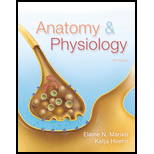
Anatomy & Physiology
5th Edition
ISBN: 9780321861580
Author: Marieb, Elaine N.
Publisher: Pearson College Div
expand_more
expand_more
format_list_bulleted
Concept explainers
Question
Chapter 16, Problem 11CYU
Summary Introduction
To review:
The bleeding disorder which results from not having enough platelets; andthat which occurs due to theabsence of clotting factor VIII.
Introduction:
The process of blood clotting involves several clotting factors, which are actually plasma proteins synthesized by the liver. Intrinsic and extrinsic pathways lead to the formation of fibrin, which
Expert Solution & Answer
Want to see the full answer?
Check out a sample textbook solution
Students have asked these similar questions
Please draw in the missing answer, thank you
Please fill in all blank questions, Thank you
please fill in missing parts , thank you
Chapter 16 Solutions
Anatomy & Physiology
Ch. 16 - Prob. 1CYUCh. 16 - List two protective functions of blood.Ch. 16 - Are plasma proteins used as fuel for body cells?...Ch. 16 - How many molecules of oxygen can each hemoglobin...Ch. 16 - Patients with advanced kidney disease often have...Ch. 16 - Which WBCs turn into macrophages in tissues? Which...Ch. 16 - Amos has leukemia. Even though his WBC count is...Ch. 16 - Prob. 9CYUCh. 16 - Prob. 10CYUCh. 16 - Prob. 11CYU
Ch. 16 - Nigel is told he has type B blood. Which ABO...Ch. 16 - Prob. 13CYUCh. 16 - The blood volume in an adult averages...Ch. 16 - Prob. 2RQCh. 16 - Prob. 3RQCh. 16 - The most numerous WBC is the (a) eosinophil, (b)...Ch. 16 - Blood proteins play an important part in (a) blood...Ch. 16 - The white blood cell that releases histamine and...Ch. 16 - The blood cell that can become an...Ch. 16 - Which of the following does not promote multiple...Ch. 16 - The normal pH of the blood is about (a) 8.4, (b)...Ch. 16 - Suppose your blood is AB positive. This means that...Ch. 16 - Prob. 11RQCh. 16 - Prob. 12RQCh. 16 - Prob. 13RQCh. 16 - What nutrients are needed for erythropoiesis?Ch. 16 - (a) Describe the process of erythropoiesis. (b)...Ch. 16 - Prob. 16RQCh. 16 - (a) If you had a severe infection, would you...Ch. 16 - (a) Describe the appearance of platelets and state...Ch. 16 - Prob. 19RQCh. 16 - (a) Define fibrinolysis. (b) What is the...Ch. 16 - (a) How is clot overgrowth usually prevented? (b)...Ch. 16 - How can liver dysfunction cause bleeding...Ch. 16 - Prob. 23RQCh. 16 - Prob. 24RQCh. 16 - Prob. 1CCSCh. 16 - Prob. 2CCSCh. 16 - Prob. 3CCSCh. 16 - Prob. 4CCSCh. 16 - Prob. 5CCS
Knowledge Booster
Learn more about
Need a deep-dive on the concept behind this application? Look no further. Learn more about this topic, biology and related others by exploring similar questions and additional content below.Similar questions
- please draw in the answers, thank youarrow_forwarda. On this first grid, assume that the DNA and RNA templates are read left to right. DNA DNA mRNA codon tRNA anticodon polypeptide _strand strand C с A T G A U G C A TRP b. Now do this AGAIN assuming that the DNA and RNA templates are read right to left. DNA DNA strand strand C mRNA codon tRNA anticodon polypeptide 0 A T G A U G с A TRParrow_forwardplease answer all question below with the following answer choice, thank you!arrow_forward
- please draw in the answeres, thank youarrow_forwardA) What is being shown here?B) What is indicated by the RED arrow?C) What is indicated by the BLUE arrow?arrow_forwardPlease identify the curve shown below. What does this curve represent? Please identify A, B, C, D, and E (the orange oval). What is occurring in these regions?arrow_forward
- Please identify the test shown here. 1) What is the test? 2) What does the test indicate? How is it performed? What is CX? 3) Why might the test be performed in a clinical setting? GEN CZ CX CPZ PTZ CACarrow_forwardDetermine how much ATP would a cell produce when using fermentation of a 50 mM glucose solution?arrow_forwardDetermine how much ATP would a cell produce when using aerobic respiration of a 7 mM glucose solution?arrow_forward
- Determine how much ATP would a cell produce when using aerobic respiration to degrade one small protein molecule into 12 molecules of malic acid, how many ATP would that cell make? Malic acid is an intermediate in the Krebs cycle. Assume there is no other carbon source and no acetyl-CoA.arrow_forwardIdentify each of the major endocrine glandsarrow_forwardCome up with a few questions and answers for umbrella species, keystone species, redunant species, and aquatic keystone speciesarrow_forward
arrow_back_ios
SEE MORE QUESTIONS
arrow_forward_ios
Recommended textbooks for you
 Human Physiology: From Cells to Systems (MindTap ...BiologyISBN:9781285866932Author:Lauralee SherwoodPublisher:Cengage Learning
Human Physiology: From Cells to Systems (MindTap ...BiologyISBN:9781285866932Author:Lauralee SherwoodPublisher:Cengage Learning Medical Terminology for Health Professions, Spira...Health & NutritionISBN:9781305634350Author:Ann Ehrlich, Carol L. Schroeder, Laura Ehrlich, Katrina A. SchroederPublisher:Cengage Learning
Medical Terminology for Health Professions, Spira...Health & NutritionISBN:9781305634350Author:Ann Ehrlich, Carol L. Schroeder, Laura Ehrlich, Katrina A. SchroederPublisher:Cengage Learning Human Biology (MindTap Course List)BiologyISBN:9781305112100Author:Cecie Starr, Beverly McMillanPublisher:Cengage Learning
Human Biology (MindTap Course List)BiologyISBN:9781305112100Author:Cecie Starr, Beverly McMillanPublisher:Cengage Learning


Human Physiology: From Cells to Systems (MindTap ...
Biology
ISBN:9781285866932
Author:Lauralee Sherwood
Publisher:Cengage Learning

Medical Terminology for Health Professions, Spira...
Health & Nutrition
ISBN:9781305634350
Author:Ann Ehrlich, Carol L. Schroeder, Laura Ehrlich, Katrina A. Schroeder
Publisher:Cengage Learning

Human Biology (MindTap Course List)
Biology
ISBN:9781305112100
Author:Cecie Starr, Beverly McMillan
Publisher:Cengage Learning

